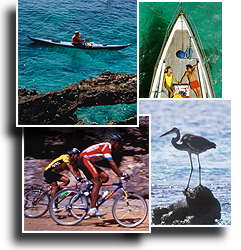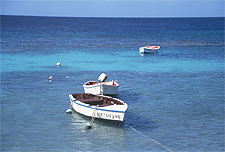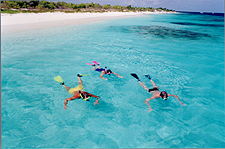|
June |
Bonaire All-Inclusive Resorts Click Here
Bonaire is a small island located in the southern Caribbean (maps) known for its pioneering role in the preservation of nature, in particular the preservation of the marine environment, and for its excellent scuba diving, snorkeling, and windsurfing, among other things.
Many descriptions and slogans have been written about Bonaire: Best Kept Secret, Unhurried, Unspoiled, Unforgettable; Diver's Paradise; and the list goes on... The fact is that all these statements are true, and then some. Another truth is the statistic that over 30% of arrivals on Bonaire are repeat visitors!
There are a number of reasons people visit our island. First timers generally have heard about the climate, the water, the sun and what there is to do. When asked, repeat visitors generally say that they did not have enough time to do all they wanted to on their first visit. If it is the third or fourth trip, the answer is basically the same but with this addition "It is the warmth and friendliness of the people" that keeps visitors returning year after year.
|



Getting to Bonaire can unfortunately be a challenge sometimes, and once you're here, you definitely need a set of wheels (Bonaire is a small island, but not small enough to walk everywhere).
Bonaire All-Inclusive Resorts Click Here
Arguably, Bonaire's main attraction is its natural beauty, both above water and below.
Below the water, colors and movement abound, dazzling the eye, while the mysterious crunching and clicking one hears offers a soothing balm to the soul. Divers and non-divers alike are amazed by the life below the waves. Corals, fish, crustaceans, nudibranchs, and even the occasional aquatic mammal are among those giving live to Bonaire's fringing reef and marine environment. Don't miss a quick look at Bonaire's Underwater Web Cam, additional web cams show the shoreline as well.
|
|
Cactus and aloe |
And, above the land, the sky is decorated with amorphous, soft wisps clouds but rarely does rain touch Bonaire's arid land. Sun touches it all day long while the constant wind cools the land. Bonaire's weather is a key contributor to its nature, and to the island's popularity with its residents and visitors.
Bonaire All-Inclusive Resorts Click Here
|
|
Strictly underwater, we have an array of fun little critters to make you smile like our frogfish. Frogfish are up to 4 or 5 inches long and come in an assortment of colors including bright yellow, red, green, white, black, and even pink. These little guys usually rest on sponges, move around by hopping along on finned feet. Ask your dive master where to look for one, and remember: Don't touch the marine life!
|
Bonaire All-Inclusive Resorts Click Here
Overview
Just
about everyone knows that "SCUBA" is an acronym for Self Contained
Under Water Breathing Apparatus. The sport has become extremely popular in the
last two decades, due in part to places like Bonaire, which has taken great
pains to preserve the underwater world by establishing one of the first marine
parks in the Caribbean. The other reason Bonaire has become such a popular
destination is the wide variety of fish life and the ease of diving that the
island offers.
|
The dozen or so Dive Operators are all members of CURO, the Council of Underwater Resort Operators. As members, they participate in establishing standards and uniform practices that, along with the Bonaire Marine Park Rules, have worked to preserve our reefs and the fragile ecosystem of the reef.
Bonaire
Dive Orientation
If
you are planning a trip to Bonaire and have a dive/hotel package you will be
given a thorough dive orientation and briefing before your first dive on the
island. One of the Bonaire Marine Park Regulations is for all visitors to do a
check-out dive as part of the briefing process before taking off on their own to
shore dive or going on a dive boat. The main reasons for this are to have each
diver check buoyancy so that damage to the reef is minimized or eliminated and
also to check out their dive equipment, whether it be rented or owned. Also,
every diver on Bonaire must purchase a Marine Park Tag valid for one calendar
year. Orientation procedures vary from dive center to dive center, so it's a
good idea to check in early.
Recompression
Chamber
In
case of a diving accident or emergency, Bonaire has one of the Caribbean's best
staffed recompression chamber. The chamber is located adjacent to the San
Francisco Hospital Emergency Room, and people in need of treatment must go to
the
|
The
Bonaire Marine Park
The
fringing reef which surrounds Bonaire is a National Marine Park from the high
water mark down to a depth of 200 feet/ 60m . Every diver who has not dived on
Bonaire within the last calendar year must attend a diver orientation dealing
with Bonaire Marine Park regulations and information. These orientation sessions
are usually held at around 9AM the morning after you arrive on Bonaire, and you
are required to attend and to obtain your Marine Park tag, which is necessary to
legally dive in Bonaire's waters. The cost of the tag is US$10, and proceeds
help support park management and services.
Bonaire All-Inclusive Resorts Click Here
|
Snorkeling
from shore for all ages. |
 |
Overview
Did
you know that world-wide, snorkelers outnumber divers by a wide margin? The fact
that less than 50% Bonaire's visitors are scuba divers is also a statistic that
proves that you don't have to go under the water to enjoy our beautiful marine
park.
If you can swim, you can put on a mask and start enjoying the wonderful sea creatures and the coral formations. You will be able to float effortlessly and observe the feeding and courtship rituals of the reefs many residents. There is nothing in Bonaire's water that is dangerous, but be sure not to touch anything as you may harm it and disturb the delicate natural balance of the reef.
Snorkeling is great entertainment for all member of the family no matter what the age. Be sure to protect yourself against the sun by using a waterproof sun block, especially on your shoulders and the backs of your legs.
Night Snorkeling is another experience that should not be missed Everything changes at night. All that is needed is a flashlight and some protection for exposed arms and legs. Night snorkeling can be done in any snorkeling area you are familiar with (snorkel it during daytime first). Enjoy the wonders of the ever changing ocean at night while some fish are sleeping and other critters are just starting their day.
Snorkeling
Tips
If
you can float, you can snorkel. In the calm Caribbean Sea you will find it easy
to float due to the fact that salt water is more dense than fresh, so you will
be able to "ride" higher on the surface than in lakes or swimming
pools at home. If you have any doubt at all about your ability or comfort level
while swimming, just find a beach with a sandy bottom, walk in to waist deep
water and lay down on your back. 99.9% of the people will float comfortably. Of
course, you are not going to snorkel on your back, so stand up, put on a mask,
and insert the mouthpiece, put your face in the water and breathe. (Those that
don't float naturally can avail themselves of a flotation device, such as a
snorkeling vest - see below.)
|
Bonaire All-Inclusive Resorts Click Here
You have reached to the perfect destination if you are looking for All inclusive vacations, All inclusive family vacations, All inclusive aruba vacation, Cheap all inclusive vacations, All inclusive cancun vacation, All inclusive mexico vacation, All inclusive Caribbean vacation, All inclusive Dominican republic vacation, Palace Resorts, Riu Resorts, Couples Resorts, Excellence Resorts, El Dorado Resorts, Secrets Resorts, Iberostar Resorts, Paradisus Resorts, Grand Lido Resorts.